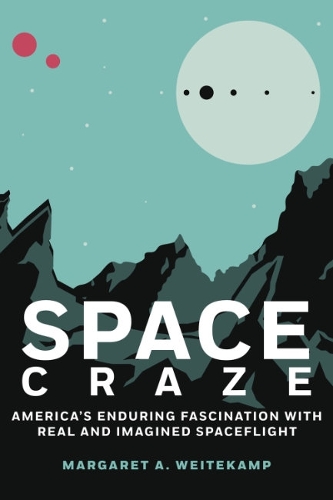
Space Craze: America'S Enduring Fascination with Real and Imagined Spaceflight
(Hardback)
Publishing Details
Space Craze: America'S Enduring Fascination with Real and Imagined Spaceflight
By (Author) Margaret A. Weitkamp
Smithsonian Books
Smithsonian Books
5th December 2022
United States
Classifications
General
Non Fiction
629.4
Physical Properties
Hardback
240
Width 152mm, Height 229mm
1g
Description
A space historian's tour through astounding spaceflight history and the Smithsonian's collection of space and science fiction memorabilia Spanning from the 1929 debut of the futuristic Buck Rogers to present-day privatization of spaceflight, Space Craze celebrates America's endless enthusiasm for space exploration. Author Margaret Weitekamp, curator at the Smithsonian's National Air and Space Museum, writes with warmth and personal experience to guide readers through extraordinary spaceflight history while highlighting objects from the Smithsonian's spaceflight collection. Featuring historical milestones in space exploration, films and TV shows, literature and comic strips, toys and games, and internet communities, Space Craze is a sci-fi lover's dream. The book investigates how spaceflight, both real and imagined, has served as the nexus where contemporary American concerns, such as race, gender, sexuality, freedom, and national identity, have been explored and redefined. Chronological chapters include- Chapter 1- Buck Rogers, Ray Guns, and the Space FrontierChapter 2- Space Forts, Television, and the Cold War MindsetChapter 3- John Glenn, the Apollo Program, and Fluctuating Spaceflight EnthusiasmChapter 4- Star Trek, Star Wars, and Burgeoning FandomsChapter 5- Generation X, the Space Shuttle, and Promoting EducationChapter 6- Space Stations, Spaceflight Enthusiasm, and Online FandomChapter 7- Streaming Services, Battling Billionaires, and Accelerated Change From the almost 650 million viewers who tuned in to watch the first steps on the Moon, to the ardent Star Trek fandom that burgeoned into a cultural force, Space Craze taps into the country's enduring love affair with space.
Reviews
Dr. Weitekamp is a dream docent, walking the readercarefully through a hundred years of design, toys, movies,books, TV shows, and countless other cultural artifacts totell the ongoing story of how space exploration has affectedour culture and vice versa. This virtuous cycle is a thrilling tale, and along the way we meet an inspiring cast of characters,all motivated by the same drive to explore and expand ourknowledge of our universe.Adam Savage, host of Adam Savages Tested and formercohost of Mythbusters
Compelling and meticulously researched, Space Crazeoffers a superb chronicling of Americas longstanding loveaffair with space exploration. From Buck Rogers and FlashGordon to Star Trek and Star Wars, Margaret Weitekampuses a curators eye to compile what is an essential toolfor understanding how space has shaped our culture.Christian Davenport, space reporter for The WashingtonPost and author of The Space Barons: Elon Musk, Jeff Bezos, and the Quest to Colonize the Cosmo
In Space Craze, Weitekamp deftly chroniclesthe expansion of the space program in the 1960s alongside our enthusiasm for space explorationas reflected in popular culture. She points out how the space program and early science fictiontelevision were initially devoid of any people of color, perfectly setting the stage to see howgroundbreaking Star Trek was in depicting a futuristic starship that included a racially diversecrew and a half-human/half-alien Mr. Spock in a position of command. Bravo.Adam Nimoy, director of For the Love of Spock
Weitekamp has produced animportant book on the firstgreat pillar of space travel:science fiction and the powerof imagination. In a readableyet detailed manner, Weitekamp cleverly employs museumartifacts to reveal the waysobjects capture elements ofnational identity and confirmsonce again that modern spacetravel is as much about thepast as about the future.
Howard McCurdy, authorof Space and the AmericanImagination
WIRED
"The first Americans to go to space and the first to travel to the moon were surely heroes, but lets be honest, theypretty much looked the same: white men who were also Christian, married, military-trained jet pilots. Early space photographers had to ask them to stand alphabetically so they wouldnt be mixed up in the captions. But Margaret Weitekamp argues that not only has that been changing, its partially the result of the evolution of space science fiction. The space historian makes a solid case that NASAand the American publichave moved beyond the Buck Rogers archetype for astronauts, with many people, though not all, aspiring to the more inclusive ideals of Star Trek. Its a smart look at the future of NASA, while digging into its past." Ramin Skibba, WIRED space writer
THE SPACE REVIEW
"The book expertly tracks [changing circumstances] in society and our interest in spaceflight, reflected not just in vehicles that fly to space but the replicas of them enjoyed by people on Earth."
Author Bio
Margaret A. Weitekamp is chair of the Space History department at the Smithsonian's National Air and Space Museum where she curates the Social and Cultural History of Spaceflight Collection encompassing some 5,000 pieces of space memorabilia and science fiction objects. She is also the author of Right Stuff, Wrong Sex- America's First Women in Space Program.
